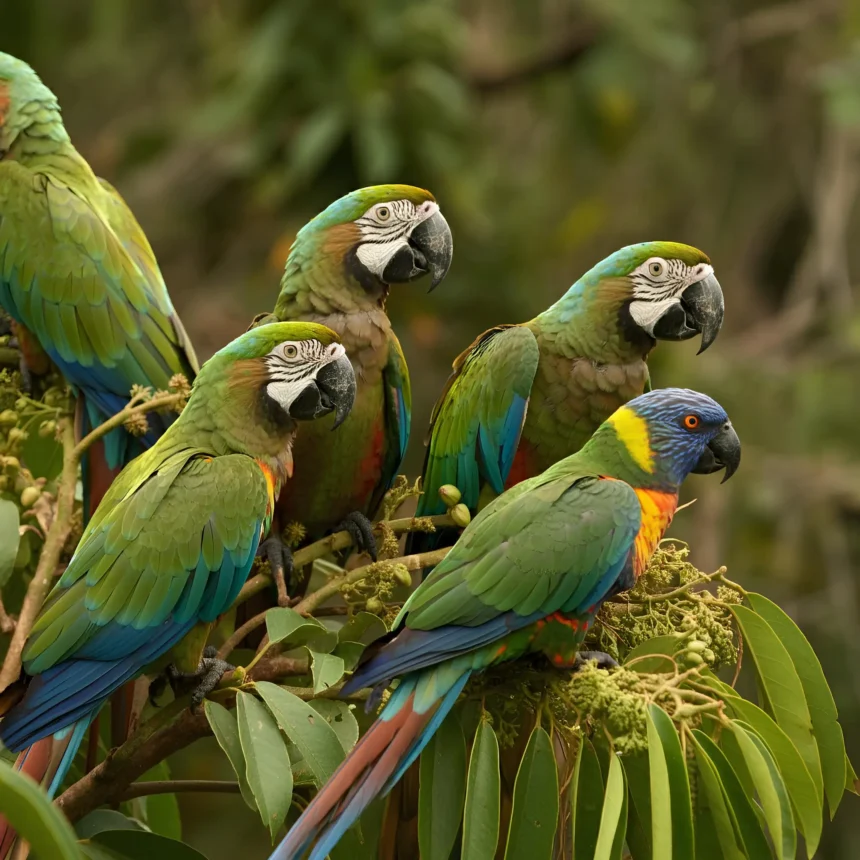Parrots Can Teach Each Other Profanity
Tourists and researchers often come across wild parrots in the forests of Australia, who curse fluently in impeccable English.
How do these birds, who have never met a human, manage to pick up such foul language? According to ornithologist Jaynia Sladek from the Australian Museum, they learn it from pet parrots that have either escaped from captivity or were intentionally released.
In addition to insults, wild parrots can mimic sounds like saws, axes, and camera clicks. They remember the noises made by tourists, ornithologists, and loggers, not only reproducing them but also teaching them to other birds.
In the Middle Ages, Parrots Were Considered Birds of Paradise
In the Middle Ages, parrots were valuable pets in Europe. They were expensive, and owning such a bird was a sign of prestige. Additionally, parrots were considered pious creatures, appropriate for respectable Christians to keep. This was no mere black cat, the tool of Satan.
He speaks articulate words so that if you don’t see the bird, you would think it is a person speaking, and naturally, he pronounces “Ave.” As for the other words, he needs to be taught.
Isidore of Seville’s Etymologies, 620 [Link]
“Ave” is the first word of the prayer “Hail Mary (Ave Maria).” Because of this, people in the Middle Ages believed that parrots were no less than birds from the Garden of Eden, praising the Holy Virgin with each call. If you have a parrot that screams in the morning, you can think for yourself if its vocalizations resemble Latin prayers.
In ancient times, however, scholars weren’t so impressed with the bird. Pliny, for example, described the parrot like this: “It greets emperors. It speaks the words it hears. Especially lewd when drunk.”
A Parrot Almost Ruined a U.S. President’s Funeral
Parrots’ ability to imitate human speech often tempts careless owners to teach them colorful language. This is an old tradition.
For example, Andrew Jackson, the U.S. president from 1829 to 1837, known for his foul mouth and unruly behavior, taught his African grey parrot named Poll an extensive vocabulary of curse words.
Jackson died at 78 from a heart attack. At his funeral, the bird suddenly began loudly spewing foul language.
Mourners panicked, covered their ears, and called upon the Lord for help.
The troublesome bird had to be removed. According to Reverend William Menefee Norment, who attended the funeral, the parrot “began to curse in the middle of the service and disturbed the people so much that it had to be taken out of the house.”
Knowing Jackson’s fiery temper and fondness for cursing, he likely would have been proud of his pet.
Parrots Are Related to Falcons and Can Be Bloodthirsty
If you’re asked to name relatives of falcons, you’d probably think of hawks and eagles. But you’d be wrong. In reality, parrots are closer relatives, along with songbirds like thrushes and orioles.
This conclusion was made by geneticists from the University of Münster. Although falcons and parrots split millions of years ago, they still share common traits—intelligence and a hooked beak. However, parrots turned to a vegetarian diet, while falcons became predators.
Not all parrots are harmless vegans, though. For instance, the Kea from New Zealand is a true killing machine.
These tough green birds with hooked beaks land on the backs of sheep peacefully grazing in the fields of New Zealand at night and peck out their fat. They leave terrible wounds, which sometimes get infected and lead to the death of livestock.
Farmers tried setting traps, but the parrots learned to deactivate them. Kea use sticks in their beaks to poke at traps, a sign of their remarkable intelligence.
Parrots Saved the Language of an Extinct South American Tribe
In the 1800s, the German naturalist Alexander von Humboldt was traveling through the jungles of Venezuela. During his expedition, he encountered a local indigenous tribe from the Carib group. They had a large collection of parrots in bamboo cages, which could speak the local language.
But one of the birds uttered words that no one could understand. Humboldt discovered that this was the language of an extinct tribe called the Atures. The Caribs had fought and wiped out its people. The survivors fled into the jungle and vanished. Only a pet parrot remained, the only being in the world that could speak the language of its lost owners.
Humboldt managed to discern and record about 40 words from the parrot’s chatter, thus preserving a small part of the Atures’ language.


